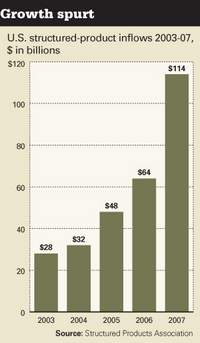 by Andrew Scherr
by Andrew ScherrSpecial to Euromoney Publications
with the Structured Products Association
“Financial weapons of mass destruction ” in the eyes of Warren Buffett, feared by government regulators, banned from the general public, and lampooned by politicians, academics and media, Structured Products are a market under assault. Even the name, “Structured Products” connotes something unnatural concocted in Dr. Frankenstein’s laboratory. Academics and populists have lined up pointing at fees, disclosures, return characteristics, and relative performance. Structured Products are held responsible for market dislocations, bank failings and all forms of economic turmoil including the current credit crises.
This fear and finger pointing is a natural response to the sweeping growth of the sometimes complex products that regulators, the media and some academics may not fully understand. When we see major hedge funds, banks and other participants disappear or become impaired overnight, it is enough to give even the most seasoned market participant pause and any segment of the market we do not fully understand becomes suspect.
And the U.S. Structured Product market has certainly blossomed. While already fundamental to European Investing, Structured Products have stormed Asia and are just taking a foothold in the U.S. where the market has been growing consistently at 60 to 80% per annum. Structured Products became deeply rooted in Europe during Unification as retail investors sought yield enhancement to counter falling bank interest rates. Next came Asia, as institutions sought principal protection on new asset classes. Canada and Latin America quickly followed. The U.S. however has been the slowest to adopt Structured Products in much the same way as it was late on the adoption of wireless telephony. With a well established infrastructure in place, it seemed less urgent to adopt the newest technology.
Furthermore, for Americans, Structured Products do not seem to make sense in the context of modern portfolio theory. To the extent that portfolios are allocated across markets based on their beta exposures, there is little room or understanding for an alpha exposure. After all, alpha is a zero sum game – or at least that is what the academics have said – and every positive alpha is offset by a negative alpha elsewhere. This is where the pendulum of active versus passive portfolios has again swung. Simply put, if you know a particular investment will pay off then go invest – otherwise, diversify.
And yet, despite all of the foregoing . . . the U.S. Structured Products industry is . . . well, exploding.
(Full article can be found on the StructuredProducts.org website by clicking here.)





